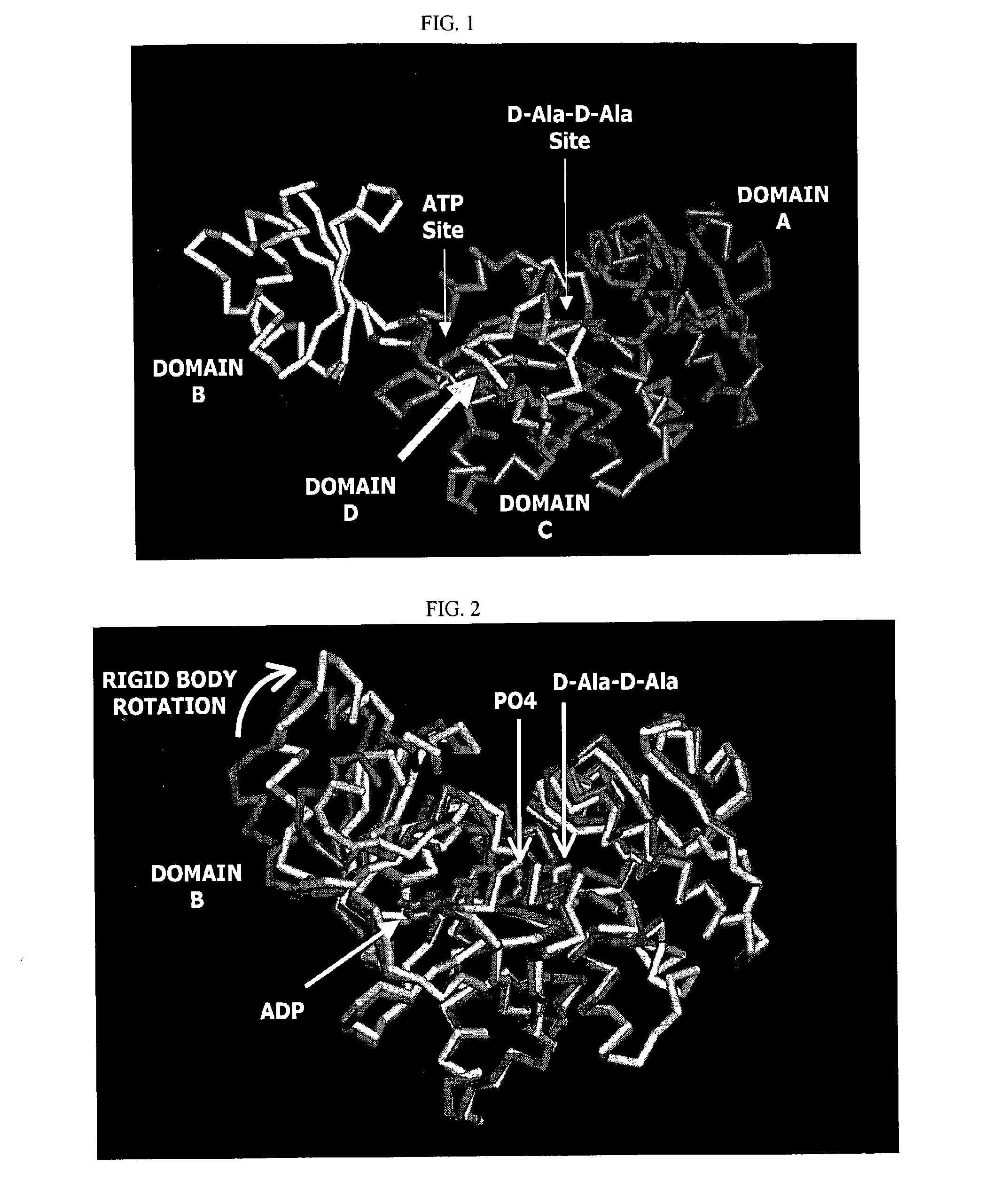Structure-based drug design methods for identifying d-ala-d-ala ligase inhibitors as antibacterial drugs
a structure-based drug design and inhibitor technology, applied in the field of new drug discovery methods, can solve the problem that no useful inhibitors have been identified that bind to the atp binding site of d-ala-d-ala ligas
- Summary
- Abstract
- Description
- Claims
- Application Information
AI Technical Summary
Benefits of technology
Problems solved by technology
Method used
Image
Examples
example 1
Methods for Protein Crystallization Data Collection, and Structure Determination
[0089] Structural information was obtained by either co-crystallizing D-Ala-D-Ala ligase in the presence of ligands or soaking ligands into preformed crystals of the protein. The first approach, produced diffraction quality crystals (hexagonal rods; 0.1 mm×0.1 mm×0.2 mm) of ligase complexed with inhibitors after five days at 18° C. by vapor diffusion in 4 μl drops, containing 5 mg / ml protein, 35 mM acetate buffer (pH 4.5), 2.75% (w / v) polyethylene glycol 6000, 4% DMSO, and a 15-100-fold molar excess of inhibitor over its K, value. In the second approach, crystals of ligase in complex with ATP were incubated in a stabilizing solution that contains 70 mM acetate buffer (pH 4.5), 5% (w / v) polyethylene glycol 6000, and a 15-100-fold molar excess of inhibitor over its Kt value.
[0090] Diffraction data was collected at −180° C. on a RAXIS IV++ imaging plate mounted on a Rigaku RuH3R rotating anode generator e...
example 3
tion of % Inhibition of D-Ala-D-Ala Ligase
[0107] The assay procedure described in Example 2 was repeated, except that inhibitor plates were prepared with 5 mM solutions of the inhibitors in the plates (rather than by serial dilutions), to result in a final concentration of 100 μM inhibitor.
Example 4—Determination of Ki and Mode of Inhibition
[0108] The assay procedure described in Example 2 was repeated, using three different substrate solutions, each in a different enzyme plate. The final concentrations in the reaction mixtures were: (A) 2 mM ATP and 1 mM D-alanine; (B) 2 mM ATP and 32 mM D-alanine; and (C) 50 μM ATP and 32 mM D-alanine. The same inhibitor plate was used with all three enzyme plates. Adenosine (Sigma) and cycloserine (Sigma) were used as controls.
example 5
tion Antimicrobial Susceptibility Test Assay
[0109] Stock solutions of tested compounds were prepared in DMF at a concentration of 5 mg / ml. Working solutions of the tested compounds were then prepared from the stock solutions, in Mueller-Hinton broth (MHB) with starting concentration of 64 μg / ml (i.e., 25.6 μL of stock solution in 974.4 μl of MHB=128 μg / ml, which was diluted with an equal volume of bacterial inoculum in the procedure that follows).
[0110] Bacterial inocula were prepared from overnight culture (i.e., one fresh colony from agar plate in 5 ml MHB; H. influenzae was grown in MHB with the addition of yeast extract, haematin, and NAD), centrifuged 2×5 min / 3000 rpm (for S. pneumoniae and H. influenzae, 2×10 min / 3000 rpm), and dispensed in 5 ml of fresh MHB each time, such that the bacterial suspension is diluted to obtain 100 colony forming units (cfu) in a microplate well (100 μl total volume).
[0111] The microplate wells were then filled with twofold dilutions of tested c...
PUM
| Property | Measurement | Unit |
|---|---|---|
| Temperature | aaaaa | aaaaa |
| Fraction | aaaaa | aaaaa |
| Angle | aaaaa | aaaaa |
Abstract
Description
Claims
Application Information
 Login to View More
Login to View More - R&D
- Intellectual Property
- Life Sciences
- Materials
- Tech Scout
- Unparalleled Data Quality
- Higher Quality Content
- 60% Fewer Hallucinations
Browse by: Latest US Patents, China's latest patents, Technical Efficacy Thesaurus, Application Domain, Technology Topic, Popular Technical Reports.
© 2025 PatSnap. All rights reserved.Legal|Privacy policy|Modern Slavery Act Transparency Statement|Sitemap|About US| Contact US: help@patsnap.com



